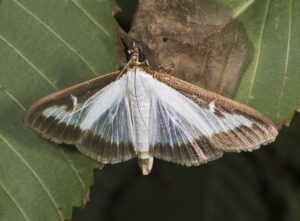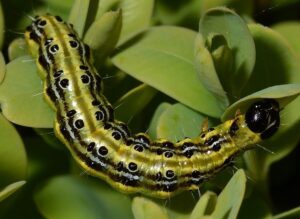Box Tree Moth
DESCRIPTION
The Box Tree Moth is an invasive pest that primarily feeds on Boxwood species. It may also feed on Burning Bush. The adult moth has a white body with a brown head and abdomen. Wings are white and slightly iridescent with a brown border and span 1.6-1.8 inches. Some adults have brown wings with a white streak. The eggs are pale yellow and can be found on the underside of Boxwood leaves. Young larvae have black heads and are green to yellow in color. As they mature, they develop dark brown stripes on their body. Mature larvae are approximately 1.6 inches long with thin white and thick black stripes and black dots outlined in white along the length of their body.
LIFE CYCLE
Adult female moths lay their eggs in clusters of about 5-20 in a gelatinous mass on the underside of Boxwood leaves. The moths overwinter in the larval stage. Once temperatures begin to rise, the larvae emerge and begin feeding (typically in March and April). Once they pupate, they spin silken webs to hold leaves together and create protection to feed. They tend to feed on the lower portion of plants but reside in the upper portion and remain active until the fall. Pupation occurs on the leaves in the silk cocoons. Adults moths emerge from the April to July depending on the climate and temperature. Adults typically live for 2 weeks after emergence.
DAMAGE
Larvae skeletonize the leaves and feed on the bark causing defoliation and dryness which leads to plant death. Signs of feeding include the presence of black frass (excrement) and webbing. Check the undersides of leaves for eggs.
CONTROL
Contact us if you suspect you have this problem. Treatment is available.




